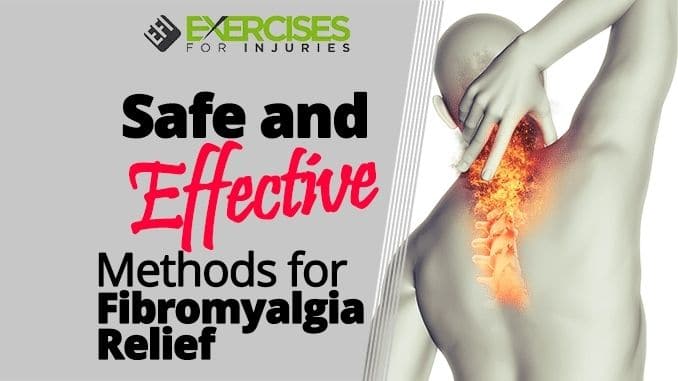
If you suffer from methods for fibromyalgia relief, then you’re all too familiar with the symptoms. Constant dull aching pain, extreme tiredness, trouble concentrating and perhaps even depression ― all things you might experience for months or even years.
Fibromyalgia can affect anyone at any age, but it occurs more commonly during middle age. Overall, the disorder affects women twice as often as men. A history of stress, accidents or injury can increase your risk for developing fibromyalgia.
Just because you suffer from fibromyalgia, it doesn’t mean you can’t lead a productive life. Having an understanding of the disorder makes a difference. Let’s look at this problem and what sort of relief options are available. Later, we’ll look at the latest research being conducted in the treatment of fibromyalgia.
What Is Fibromyalgia?
Fibromyalgia can be thought of as a syndrome or cluster of problems. The central hallmark of fibromyalgia is widespread musculoskeletal ― muscle, bone and body ― pain. If you have experienced this kind of pain for more than three months ― with no obvious explanation ― then there’s a good chance you have fibromyalgia.
The symptoms of fibromyalgia may include:
- Widespread body pain and/or stiffness for more than three months, on both sides of the body
- Fatigue and tiredness even after sleeping; sleep may be disturbed by pain or other problems like sleep apnea
- Trouble focusing or paying attention
- Tingling in hands or feet
- Depression
- Headache
- Stomach pains
What Causes Fibromyalgia?
Nobody is 100% sure about the cause of fibromyalgia, but there are many theories behind the disorder. For example, some evidence appears to show a genetic component, that is, fibromyalgia can run in families. Other research indicates that infections may be a part of what causes or worsens fibromyalgia symptoms. Finally, there seems to be a strong link with emotional stress for those that suffer from the disorder.
Research also points toward the possibility that a specific brain chemical, called serotonin, is low in people with fibromyalgia. Still, medications that treat this chemical imbalance don’t seem to treat the disease completely. The current consensus is that fibromyalgia is probably caused by a variety of factors. Also, the disorder may not be due to the same causes in all people.
Treatment of Fibromyalgia
The treatment of fibromyalgia is complex. Part of the problem is that no one is sure exactly what causes the syndrome. Also, different people react to different treatments and none of them work for everyone. Finally, even in one person with fibromyalgia, a treatment that worked in the past may lose its effectiveness over time. In many cases, the treatment of fibromyalgia is by trial and error. However, there are some basic treatments that many doctors and patients find successful.
Pain Medications
In most people with fibromyalgia, some kind of pain medication is typically used during the disease. The drug categories are:
- Over-the-counter (OTC) or prescription-strength acetaminophen, ibuprofen or naproxen
- Nonnarcotic prescription pain medication such as tramadol
- Narcotic medications are usually not prescribed due to their highly addictive potential.
Antidepressant Medications
Fibromyalgia can be associated with low brain serotonin levels. This might be part of the reason some people find relief from fibromyalgia when treated with Duloxetine (trade name Cymbalta). One of the effects of this drug is that it leads to increased brain serotonin levels. Other antidepressants may be used, and it’s not clear if relief comes from a direct biochemical response. Another explanation could be that if you are not as depressed, the pain might not bother you as much.
Antiseizure Drugs
Some doctors treat fibromyalgia with medications also used to treat seizures. Examples of drugs in this category are Gabapentin (Neurontin) and Pregabalin (Lyrica), which was the first drug approved by the U.S. FDA to treat fibromyalgia.
Other Methods of Relief for Fibromyalgia
Given the complexity of the disorder, many differing opinions have arisen regarding the best methods for fibromyalgia relief beyond medication use. Although the evidence isn’t conclusive, the following are methods some people have found helpful.
Physical Therapy
For the best results, it helps to find a physical therapist with experience in treating people with fibromyalgia. There are some reports that the following treatments might bring some relief to your symptoms:
- Cardiovascular exercise: This could include running, jogging or other aerobic exercise
- Physiotherapy: This is comprised of special exercises, movements, massages and local heat
- Cryotherapy: Therapists apply extreme cold to parts of the body to relieve pain; it may work by affecting the nerves that sense pain
- Trigger point injection: Specific areas of pain are injected with a local anesthetic, saline or corticosteroid (“steroids”)
- Massage therapy: Certain parts of the body are rubbed and manipulated to bring relief
- Acupuncture: Very thin needles are inserted into the skin; this possibly acts upon nerve endings or trigger points
- Biofeedback: By applying sensors to your muscles, this treatment trains you to be more aware of muscle tension
- Transcutaneous electrical nerve stimulation (TENS): This method delivers low-voltage electricity through electrodes connected to the skin; the reason this works may be similar to trigger points and acupuncture
Stress Reduction
Due to the fact that methods for fibromyalgia relief have an emotional element, stress reduction techniques may also help decrease your symptoms. Some stress-reducing modalities include:
- Controlled breathing: Involves taking long slow breaths in and out, with pauses in between; concentrate on the act of breathing to reduce stress
- Muscle relaxation: This method has you contract and then relax a specific muscle in your body one at a time like hand, arm, leg, stomach or face; tighten the muscle hard for about 10 seconds, and then relax for 10 seconds; focus on the muscle being contracted and releasing tension
- Cognitive-behavioral therapy: Involves coaching by a mental health therapist to help you change how you perceive and react to stress
- Relaxation techniques: This can include repetition of words, phrases, thoughts or movements, and some variations of this may be yoga or mindful meditation
- Psychological counseling: Being able to talk to a mental health specialist may help with fibromyalgia symptoms and identify areas of stress in your life
Online Support Groups
Support groups may not lead to you being free from fibromyalgia symptoms but sharing your struggles can be a great help. Also, people usually share unorthodox ideas of how to cope with the disorder. You might find that what works for others, works for you too. Some popular online groups are fibromyalgia forums and fibromyalgia support group.
Ongoing Research
Doctors and researchers are constantly trying to figure out how to cure or relieve fibromyalgia. Some of the current research points towards these factors as having a potential impact:
- Sleep: Due to the associated sleep disorders, getting adequate rest seems to be central to methods for fibromyalgia relief treatment. Adjusting the timing of pain relief medications and practicing good sleep hygiene may make a big difference. Cognitive-behavioral therapy that focuses on sleeping habits may also be important.
- Swimming: This exercise has been known to relieve many musculoskeletal problems. New research shows that swimming may be beneficial to fibromyalgia as well. The mechanism of relief may be both physical and emotional as exercise helps your body and lifts the mood.
- Oxygen therapy: Some newer research shows that high-pressure oxygen might provide people with relief from fibromyalgia. In the study, some patients were able to discontinue their pain medications completely. The treatment is complex as it involves using a special oxygen chamber (hyperbaric). However, research in this area may pave the way for future breakthroughs about the effect of oxygen on fibromyalgia.
- Vitamin D supplements: One study showed that vitamin D supplements may provide partial relief to pain associated with fibromyalgia. The promising aspect of this treatment is that vitamin D is low cost. Plus, the vitamin does not have the side effects or risk associated with other medications used to treat the disorder.
Conclusion
Fibromyalgia is a complex cluster of symptoms that affects millions of people worldwide. Even though the cause and cure have not been identified, there are safe, effective treatments. Sometimes, the pain from fibromyalgia can decrease or go into remission, but it may return again. Effective treatment often involves a medical team effort and significant patient support and education.
If you want to learn the secrets of foods that will help you turn back the hands of time and restore your natural vitality and slimmer body, then check out the Best Foods That Rapidly Slim & Heal In 7 Days program, here!




